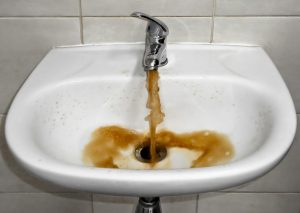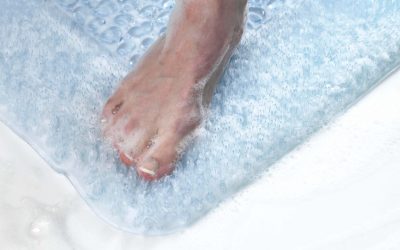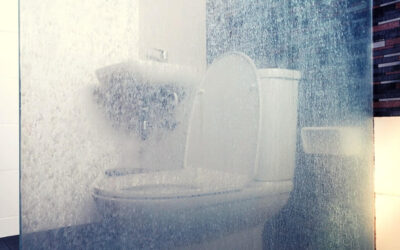As time goes by, your enamel coated bathtub may start to develop brown stains. This could be caused by hard water, mineral deposits, and iron or tannins in the water among other causes. A stained tub is not pleasing to look at or bathe in so in this article, we shall talk about how to remove brown stains in an enamel bath tub.
We shall also have a deeper look at the possible causes of the brown stains and the appropriate ways to get rid of them.
It is important to note that enamel is very delicate; hence, it is prone to scratches and chipping. For this reason, harsh and abrasive cleaners like steel wool should be strictly avoided when cleaning.
Cleaning solvents that are highly acidic should also be avoided to prevent dulling of the enamel finish and overall degradation of the tub.
What causes brown and yellow stains in porcelain, enamel, or acrylic bathtub
1. Iron in water causes rust
Iron in the water is actually the major culprit of the reddish-brown or yellowish-brown stains in your tub or toilet.
When iron gets dissolved in the water, it is oxidized to form iron oxide, which is the chemical name for rust.
If your tub or toilet is exposed to this rust over a period of time, brownish stains will start forming.
It is therefore important to get rid of these stains as soon as you notice them. This is because once rust sets in on the tub, it may be very difficult to remove.
2. Hard water that causes limescale
About 85% of the USA is reported to have hard water. So there is a high possibility that you live in a hard water city.
Hard water is also a major cause of brown stains in an enamel tub due to limescale.
Limescale forms as a result of minerals from the hard water like calcium, iron, and magnesium that build up over time.
The thick coating created on the tub by limescale not only makes the tub very ugly but is also very difficult to remove.
It is therefore important to prevent its formation or use limescale removers regularly when cleaning the bathroom.
3. Tannins
Tannins are decayed organic matter that finds their way into the water.
Although tannins are not harmful, the yellowish-brown color tends to stain laundry and fixtures like bathtubs and sinks.
The water also has an after taste and an earthy odor that makes it difficult to drink.
The best way to get rid of tannins in the water is by using a tannins filter.
4. Soap scum and grime
Soap scum occurs when soap reacts with minerals like calcium and magnesium in hard water to form a hard insoluble substance.
Grime on the other hand occurs as a result of oils in the soap mixing with minerals in the water.
Scum and grime build-up cause stains that are not easy to get rid of.
Thus, it is important to rinse off your tub after a bath or shower and clean it regularly with the appropriate cleaning agents to prevent the build of scum and grime.
See also: Best bath mat for refinished tub
How to remove brown stains in an enamel bathtub
As earlier mentioned, enamel tubs are very delicate so you must be very careful when choosing the cleaning agents to use.
Natural stain removers like baking soda, salt, and lemon are ideal since they are not harsh.
1. Baking soda
This is a common household product that is very effective at removing stains as well as absorbing odors.
To remove stains in an enamel tub, mix ¼ cup of baking soda with warm water to make a thick paste. Apply the paste on the stained areas in the tub and let it sit for about 5 to 10 minutes.
Take a soft cloth or sponge and scrub gently the tub to remove the stains and then rinse off with clean water.
If the stains are tough, you may need to use a stronger stain remover like white vinegar.
2. Diluted white vinegar
Pure vinegar can easily damage enamel so it is advisable to dilute it with warm water first.
Take a sponge, dip it into the diluted vinegar and start scrubbing the tub gently paying extra attention to the stained areas.
You can also mix the diluted vinegar with baking soda for very tough stains.
Rinse the tub thoroughly after cleaning and leave it to air dry.
3. Salt and lemon juice mixture
Salt and lemon juice work particularly very well on rust stains on enamel or porcelain tubs.
Simply pour salt on the stained areas and juice lemon on it.
Let it sit for about 5 minutes and then scrub gently with a soft sponge. You can also scrub using a slice of lemon.
Rinse and repeat the process for tough stains.
4. Use commercial stain removers
If none of the above household products seem to work, you can try commercial stain removers.
For stains caused by hard water, this Bio-Clean Stain Remover is perfect. It is non-toxic and biodegradable. Most importantly, to work very fast to remove stains with very little effort.
Bio-Clean also works on rust stains. It oxidizes the brown stains within minutes so you don’t have to do a lot of scrubbing.
Soap scum and grime removers are also widely available such as The Bucko Cleaner.
It dissolves soap scum and grime within minutes leaving the tub sparkling clean. It has a light scent of lemon with no toxic fumes and bleach so it is very safe to use at home.
5. Cream of tartar cleaner mixed with hydrogen peroxide
Cream of tartar is a non-abrasive yet powerful cleaner.
It is a good alternative to household bleach, especially when mixed with vinegar or hydrogen peroxide.
To clean the tub, mix about 3 tablespoons of cream of tartar with a few drops of hydrogen peroxide to make a thick paste.
Apply the paste over the brown stains and allow it to sit for about an hour.
Take a sponge and wipe the paste while rubbing gently and then rinse off with clean water.
How to prevent brown stains in enamel, porcelain, and acrylic tubs
It is better to prevent to formation of stains on the bathtub than to struggle to get rid of them later.
So below are some of the ways you can avoid brown stains in your tub.
1. Soften the water
To prevent stains caused by hard water, you will need a water softener.
Water softeners help to remove ions like magnesium and calcium that are responsible for the hardness in water.
To soften the water, you can use whole house filtration systems, whole house water softening systems, or a combination of both.
Most water filters are not made to remove minerals rather they help to filter out sediments, tannins, and other water contaminants.
Water softeners on the other hand are designed to get rid of minerals that cause hardness or alter their structure so that they don’t attach to surfaces and appliances.
Thus, softeners like Fleck 5600SXT are more efficient for whole house water softening.
2. Clean the tub after every use
If you want to get rid of brown stains, you should clean the tub after every use. You and your family members must agree to follow the routine of using the bathtub then cleaning it.
See also: How long to wait after reglazing bathtub to take a shower
3. Close the faucets tightly to prevent leaking
When hard water constantly drips onto the tub, it is likely to cause stains over a period of time.
Thus, it is important to ensure the faucets are tightly closed all the time.
If the faucet keeps leaking even after closing tightly, you will need to replace it with a new one that is working properly.
Conclusion
In this article, we have discussedhow to remove brown stains in an enamel bath tub.
Enamel is very delicate, so you need to be very careful with the cleaning products you use.
Baking soda, salt, vinegar, and hydrogen peroxide are readily available household products that are delicate yet powerful on stains.
If you choose to use a commercial stain remover, make sure it is not toxic and eco-friendly.
Most importantly, don’t wait until the tub is extremely stained. Prevent the stains by cleaning the tub after each use, using a water softener and ensuring the faucets do not leak.









